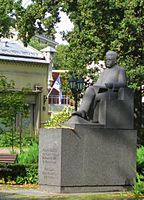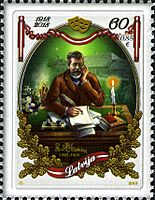Rūdolfs Blaumanis facts for kids
Quick facts for kids
Rūdolfs Blaumanis
|
|
|---|---|
 |
|
| Born | 1 January 1863 Ērgļi, Russian empire (Now Latvia) |
| Died | 4 September 1908 (aged 45) Punkaharju, Russian empire (Now Finland) |
| Occupation | Poet, Playwright, translator, journalist |
| Language | Latvian, German |
| Literary movement | Realism |
| Signature | |
 |
|
Kārlis Rūdolfs Leonīds Blaumanis (1863–1908) was a famous Latvian writer, journalist, and playwright. Many people think he was one of the best writers in Latvian history. He was especially good at writing in a style called realism, which means showing life as it really is. The apartment building in Riga where he once lived is now a museum. It's called the Janis Rozentāls and Rūdolfs Blaumanis museum, honoring him and another artist.
Contents
A Writer's Life: Rūdolfs Blaumanis
Early Life and Education
Rūdolfs Blaumanis was born in Ērgļi, Latvia, on December 20, 1862. His father, Matīss Blaumanis, worked as a cook at the local manor house. His mother, Karlīne, was a housemaid.
Rūdolfs started school at a private school in Ogre parish. He studied there until 1875. After that, he moved to Riga and attended a German merchant school. He finished his studies in 1881.
First Steps in Writing
After graduating, Blaumanis began working as a clerk for a trading company. During this time, he started writing his first stories. His very first published work was a story called Wiedergefunden. It appeared in a German newspaper, Zeitung für Stadt und Land, in 1882.
In 1882, he went back to his family home, Braki, and stayed there until 1885. This time helped him learn even more about the Latvian language. In 1885, he became a secretary at the Koknese manor. He also studied to become a steward, which is like a manager of an estate. He worked there for two years. His first work in Latvian, a poem called Nakts (Night), was published in 1886.
From 1887 to 1889, he lived at Braki again. During these years, he wrote several novels in both Latvian and German.
Moving to Riga and Becoming a Playwright
In 1889, Blaumanis moved to Riga. Two years later, he started working for the newspaper Zeitung für Stadt und Land. He wrote articles about Latvian culture for the paper. In 1890, his first play, Zagļi (Thieves), was performed in Riga. Over the next few years, many more of his plays were staged and became very popular.
His stories also gained attention outside Latvia. In 1892, a collection of his novels was translated into Estonian. Later, more of his works were published in Estonia.
Return to Braki and Later Years
After his father passed away in 1894, Blaumanis returned to his family home in Braki. He lived there for four years and tried to become a farmer. Later, he worked briefly for Dienas Lapa, a major newspaper of the New Current movement. He wrote funny articles, known as satire, against a style of writing called romanticism.
In 1898, he moved back to Riga. He worked for a big journal called Home Guest with other famous writers like Aspazija and Jānis Poruks. In 1900, he published a collection of poetry with his friend Andrievs Niedra.
In 1901, Blaumanis moved to St. Petersburg, Russia. He worked there as a journalist and editor for a Latvian newspaper, Pēterburgas avīzes. He was in charge of the newspaper's satirical section.
Final Years and Legacy
By 1904, Blaumanis faced money problems and his health was getting worse. He returned to Latvia and lived at Braki until 1906. During this time, he wrote some of his most famous plays. He didn't directly join the Revolution of 1905, but he supported other writers who were involved.
In 1906, he moved to Riga again. He started working for the newspaper Latvija, where he also led the satirical section. During this period, he shared an apartment in Riga with his close friend, the painter Janis Rozentāls.
In 1908, Blaumanis's health continued to decline. He couldn't afford medical treatment at first. However, other Latvian writers started a fundraising campaign to help him. In late summer, with the help of J. Rozentāls and his Finnish wife, Blaumanis was able to travel to Finland for treatment.
Sadly, it was too late. He passed away on September 4, 1908, at a sanatorium for people with tuberculosis in Punkaharju, Finland. He was buried in his home village of Ērgļi.
Today, his family home in Braki is a museum and a special place to remember him.
Remembering Rūdolfs Blaumanis
- The House Museum for Rudolf Blaumanis "Braki" opened in 1959. It helps people learn about his life.
- There is also the Museum of Janis Rosenthal Rudolf Blaumanis in Riga, at Alberta Street, 12. This was his memorial apartment.
- In Sigulda, a monument to Blaumanis was built in 1988 by sculptor I. Dobychin. It stands at the crossroads of Darza and Parka streets.
See also
 In Spanish: Rūdolfs Blaumanis para niños
In Spanish: Rūdolfs Blaumanis para niños







